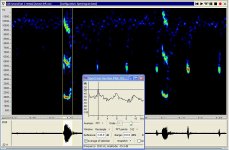You are right ,a few chip chop Noctule and lots of Daubenton's. The Daubenton's have such a flat regular tone. Worth remembering the narrow wings of Noctule, they belt about shouting loudly at 20khz over open country often high, as one of the largest species they are very distinctive and often out before dark. Serotines are broader winged and often fly along tree lines. If you set your detector to 20Khz when noctules are around the chip chop sound is really clear. Their chestnut colour is great if the light is good enough.
I have no experience using FD detectors for sonograms, I use a TE detector the following link has some information on the limitations of FD detectors
http://www.batsound.com/psonfaq1.html I think you may have some problems with analysis due to this limitation in harmonic analysis. A noctule sonogram using a TE detector has maximum power output at 20khz and the sonogram would not show the other pulses at that power level if it showed them at all,
http://www.batcon.org/batsmag/v19n4-06.html shows this. The problem as far as I can understand your sonogram is the 3 pulses presumably caused by the Noctule all show similar power amplitudes so selecting the 20khz level is based on the supposed id of Noctule and knowing that is the "right" frequency. In this case listing to the sound file its clear this is correct. The 3 pulses probably are an artefact of FD detectors as they do not appear on a TE sonogram; the Daubenton's seem to be clearly represented, but not showing the same shape as in the TE sonogram link .
Its easy sometimes to miss the other species on a sonogram and getting used to dark bush crickets where they are common. Is this problem with the noctule a result of the fundamental frequency problem mentioned on the batsound website. Perhaps they would respond to an email, I've found them helpful in the past. Otherwise try Bristol university or some other such source. The best solution is to use TE, the cost is higher, but TE is going to give you a picture of real sound with less artefact risk. Not that sonograms are quite what you at first hope, not certain id for everything, but they are a big aid. I recommend Frank Greenways course at Juniper hall if its still running. Seeing bats attracted into mist nets by pre recorded sound is incredible, especially when you are dealing with Bechstein's. The bat conference often have sonogram workshops as well.




